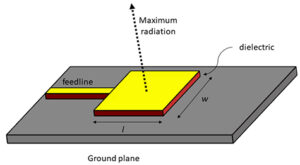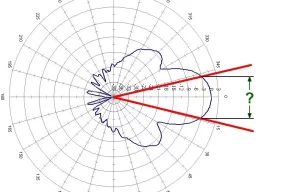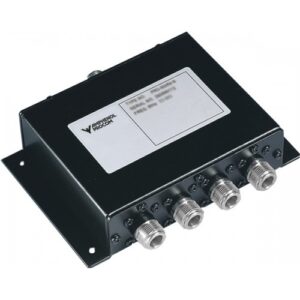Table of Contents
Astronomical Phenomena
Astronomical sources are an enormous source of radio waves. Among astronomical sources, the most well-recognized in emitting radio waves are a type of neutron star known as pulsars. For example, the pulsar PSR B1937+21 rotates 642 times per second and its remarkably regular radio wave pulses serve to allow physicists to study the material of spacetime. Some pulsars called millisecond pulsars can rotate several hundred times a second, emitting as many as 1,000 pulses in one second.
Other major natural sources of radio waves include the Sun: at the height of Solar Cycle 24 in 2013, the Sun produced a large number of radio bursts, several of which exceeded 10,000 SFUs in intensity. Such bursts interfere with satellite communications, GPS systems, and sometimes even with short-wave radio communications on Earth.
Galaxies, especially those with AGN, are capable of producing very powerful radio waves due to their supermassive black holes. One of the brightest radio sources in the sky is a galaxy known as Cygnus A, which consists of lobes that emit radio waves with frequencies of approximately 1.5 GHz. The energy output from the radio lobes of Cygnus A is equivalent to the conversion of 10^7 solar masses into pure energy over millions of years.
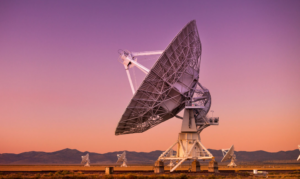
Lightning
Whenever there is a lightning discharge, it generates very powerful electromagnetic radiation, including radio waves in the VLF and LF bands. A single lightning stroke can radiate up to 10^9 watts of radio energy depending upon the intensity of the discharge. Global estimates put this number at about 44 strikes per second, which would translate to close to 1.4 billion strikes per year. This high strike rate produces a constant background of radio wave activity referred to as “sferics,” short for atmospheric electromagnetic signals.
Low-frequency radiations could attain as far as several thousand kilometres, by jumping between the surface of the Earth and the ionosphere. In the range of 1 KHz to 10 KHz frequency, whistlers fall and, thus study of the ionospheric properties of Earth use it.
Large lightning events in planetary atmospheres, such as those that take place on Jupiter and Saturn, also produce radio waves. For example, Jupiter produces radio bursts owing to the high level of lightning activity and its interactions with the magnetic field. Radio emissions from lightning in Jupiter have been recorded within a frequency window from 0.1 MHz to 40 MHz by space probes such as Voyager 1 and Juno.
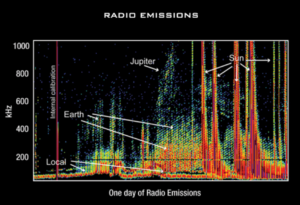
Earth’s Ionosphere
The ionosphere is a very important natural source of radio waves of the Earth. The region of space from about 60 to 1,000 kilometers above the surface of the Earth contains charged particles that produce and reflect radio waves. During the day, the electron density in the ionosphere increases to about 10^10 electrons per cubic meter and decreases at night to about 10^8 electrons per cubic meter due to solar activity and altitude.
Of all the radio wave phenomena of the ionosphere, one of the most astounding is auroral emission. The charged particles from the solar wind striking the ionosphere generate these emissions, which could give rise to radio waves in the range of Very Low Frequency radio waves typically between 3 kHz and 30 kHz. the geomagnetic storm in March 1989 produced auroral radio emissions observable over great areas and disrupted radio communication and electrical power supplies in Canada.
The ionosphere produces other natural radio sources commonly called “hiss” and “chorus.” These emissions fall between the range of 1 kHz and 10 kHz. The sources of hiss and chorus are interactions among energetic particles and the magnetic field of the Earth. Other research work, including those from satellites like the Van Allen Probes, has shown that chorus waves can accelerate electrons in the Earth’s radiation belts to nearly the speed of light. The strongest amplitudes for chorus waves occur during morning hours with intensities up to 10^-9 W/m².
High Frequency radio waves are reflected back by the ionosphere, making it possible to transmit signals beyond the horizon. This phenomenon is called “skywave propagation,” which amateur radio operators and military communication systems use. The signals of HF radios from 3 MHz to 30 MHz, for instance, can bounce between the ionosphere and the Earth’s surface as long as 4,000 kilometers per hop. During the solar maximum in 2013, the increased ionospheric disturbances caused serious disruptions to HF communication systems worldwide.
Broadcasting Systems
Broadcasting systems are a primary man-made source of radio waves, designed for the transmission of audio, video, and data across large distances. Radio broadcasting typically uses frequencies in the AM (530–1710 kHz) and FM (88–108 MHz) bands. The AM radio station can operate up to 50 kW power serving up to a 200-kilometer radius. While FM stations with much finer sound quality would be operated at 100 kW, this serves only approximately 80 km due to the line-of-sight propagation.
Television broadcasting is allocated another part of the frequency spectrum VHF from 30 – 300 MHz, UHF from 300 to 3000 MHz. In TV transmission, a single high-power transmitter may be sufficient to serve an area as large as a radius of 100 kilometres or even more depending upon topography and antenna height. For example, the same urban and rural population is adequately served by a broadcasting tower at 1,000 feet tall transmitting 500 kW in the UHF band. Digital signals are of lesser bandwidth and, therefore, the broadcasters can transmit several channels on the same frequency. This transition also led to the reduction of power consumption; in general, the digital TV transmitter operates on 20-30 percent lower power than its analogue counterpart.
Satellite broadcasting systems include DTH television transmission. These systems operate in the Ku-band range of frequencies, which falls between 12–18 GHz and C-band between 4–8 GHz. These systems work on satellites positioned in a geostationary orbit at an altitude of approximately 35,786 kilometres above the surface of the Earth. In contrast, a satellite such as the Intelsat 20 that operates with a transponder bandwidth of 36 MHz could broadcast hundreds of TV channels to tens of millions of households throughout Asia and Africa. This class of satellites cost anywhere from $100 million up to $400 million.
Wireless Communication Devices
Wireless communication devices are among the most widespread sources of radio waves, enabling seamless connectivity across various applications. Mobile phones, a cornerstone of modern communication, operate within frequency bands ranging from 700 MHz to 2.6 GHz for 4G LTE networks, and 3.3 GHz to 4.2 GHz for 5G. A single cell tower can handle thousands of active connections simultaneously, transmitting signals with power levels of up to 20-40 W per sector.
Wi-Fi networks, another key application, utilize the 2.4 GHz and 5 GHz bands to provide local wireless connectivity. A typical Wi-Fi router transmits signals at power levels of 100 mW to 1 W, covering an area of up to 50 meters indoors and 100 meters outdoors. Advances in Wi-Fi standards, such as Wi-Fi 6, have improved data transfer rates to 9.6 Gbps, nearly three times faster than Wi-Fi 5, while maintaining backward compatibility. Bluetooth technology, operating in the 2.4 GHz band, is widely used in wireless peripherals such as headphones, keyboards, and smartwatches. Bluetooth devices typically transmit at power levels of 1 mW to 100 mW, depending on the device’s range requirements. For instance, Class 1 Bluetooth devices have a range of up to 100 meters, while Class 3 devices are limited to 1 meter.
Radar and Navigation Systems
It finds essential applications in radar and navigation systems. In fact, radar systems work on the principle where they transmit radio waves and detect their reflections from the objects that come their way. The general tendency is to use frequencies of the S-band range (2–4 GHz) and X-band range (8–12 GHz) for weather observations, air traffic control, and military operations. For instance, weather radars such as the NEXRAD network in the United States operate at about 2.7 GHz and are able to detect precipitation within a radius of 230 kilometers, feeding data in real time for storm tracking and weather forecasting. Each NEXRAD station covers a 250 km area and costs approximately $10 million to build and maintain.
Navigation systems use radio waves to provide exact positions of items. GPS satellites broadcast at 1.575 GHz, referred to as the L1 band, and 1.227 GHz, known as the L2 band, enabling receivers to calculate positions with accuracy up to 5 meters in standard mode and as close as 10 centimeters in advanced configurations using differential GPS. The GPS constellation involves at least 24 operational satellites at 20,200 km above Earth’s surface, constantly sending out their signals.
Marine navigation systems comprise another critical use of radio waves and guarantee the safety of boats. It works in both X and S bands. The output is varied from 4 kW to 25 kW. X-band radar is very accurate and can detect objects as small as 1 meter in size at distances out to 12 nautical miles. The International Maritime Organization requires that all ships over 300 gross tons be equipped with radar, indicating just how crucial the technology is to commercial and industrial shipping.

